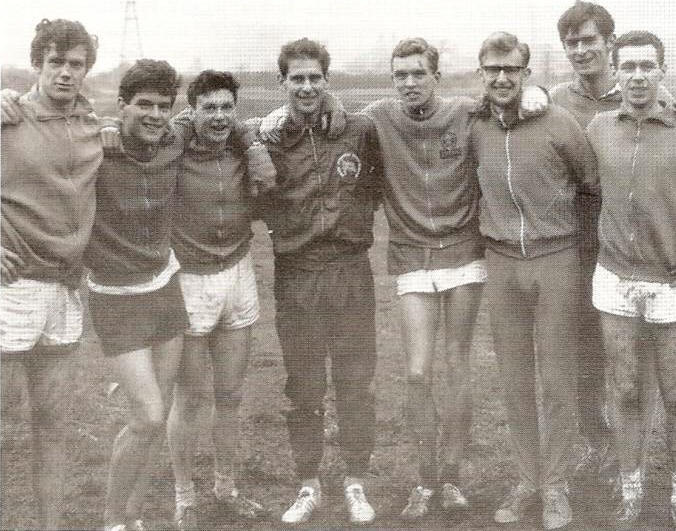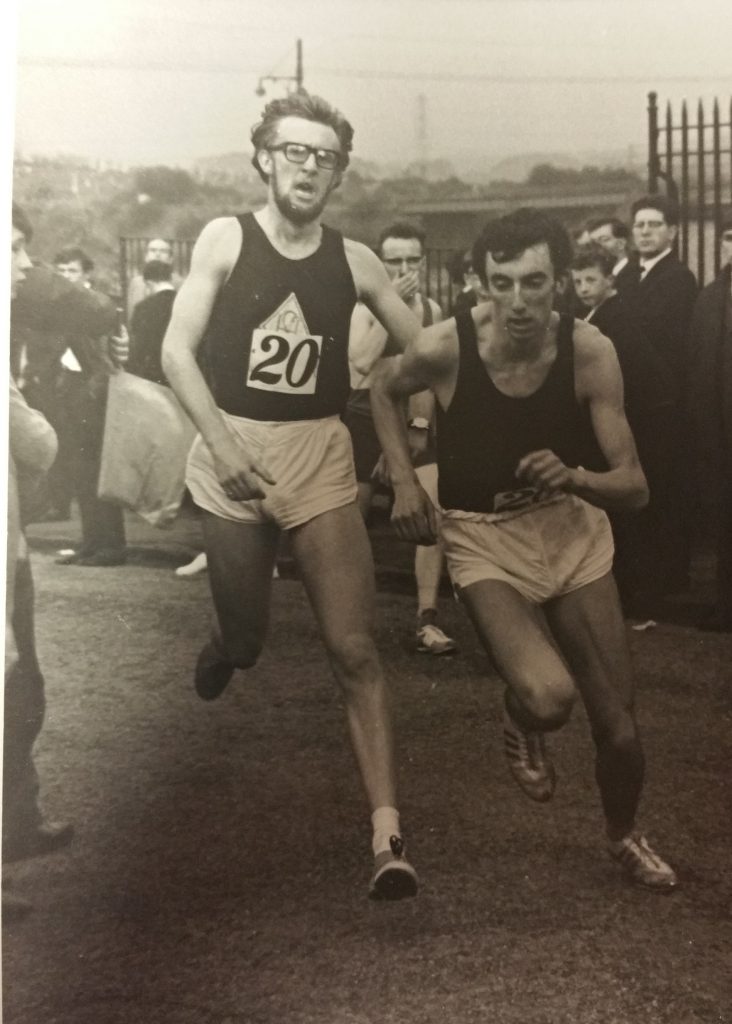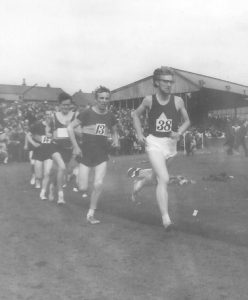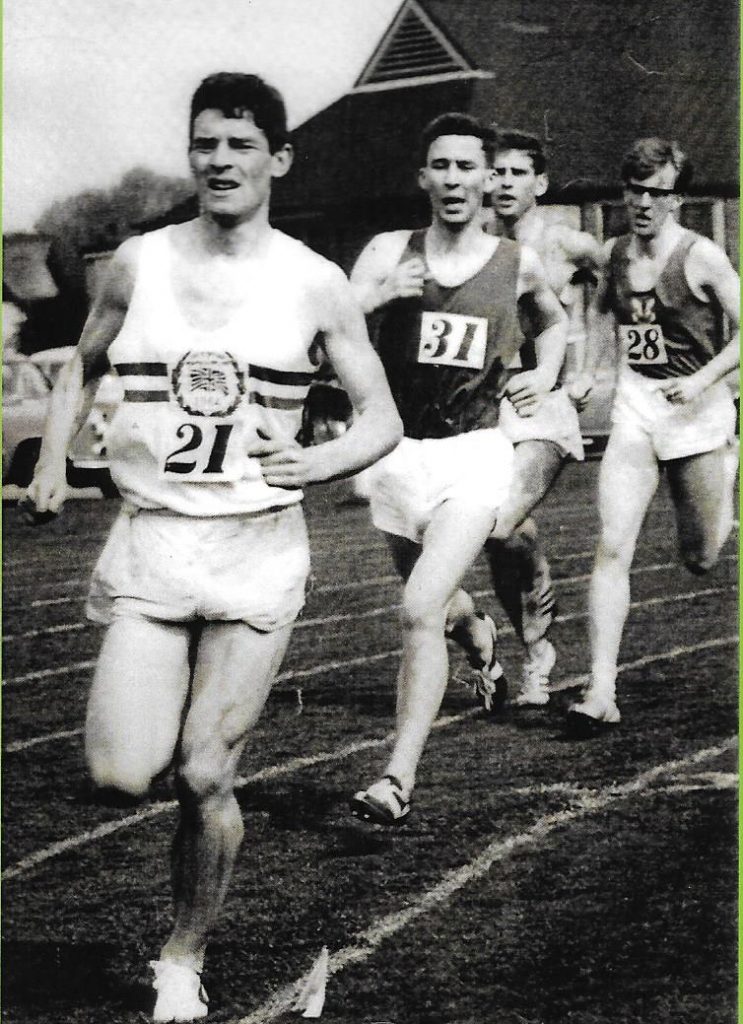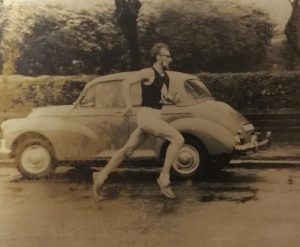The great Edinburgh University team of the 1970’s: Ian Young third from right
The Edinburgh University team of the late 60’s/1970’s is generally recognised as the best ever University squad to come out of Scotland, and indeed they were a superb team by any standards. One of the regular members of team alongside Fergus Murray, the Wight brothers, Chris Elson, Dave Logue, Gareth Bryan-Jones and the rest was Ian Young. Ian had been a member of Springburn Harriers at Kirkintilloch in Dunbartonshire who already had a good pedigree in the sport before he went to Edinburgh from Lenzie Academy.
His coach was Eddie Sinclair who went on to coach many British as well as Scottish international runners and his Springburn club teams became legendary. Ian’s contemporaries included such as Eddie Knox and Duncan Middleton – the former became world junior cross country champion and the latter GB indoor 880 yards champion as well as Scottish record breaker for 880 yards. Ian’s first season in the sport was 1960/61 when,as a runner in the Under 15 Boys age group he was tenth in the Midland District Championship – one place behind team mate Middleton – and then one place lower down in the National where Middleton was sixth. The team difference was that they were fourth in the District championships but third in the National. Ian was in the Youths (Under 17) age group in 1961/62 and finished twelfth in a race where the first three were AP Brown, Ian McCafferty and Hugh Barrow. His second year as a Youth saw him third in the District championships leading his team into first place with Duncan Middleton and David Tees the other runners. In the National that season he was second, with Middleton sixth, for the team that finished second. Note that he was only beaten by Ian McCafferty who had eleven seconds on him at the finish. In 1963/64 he was up an age group and racing against the Under 20’s in the Junior Man age group. He finished seventeenth in the National and the team was fourth and just out of the medals.
It was clear Ian’s ability, together with family support and Eddie’s training, was producing some remarkable results. The high points of his career so far can be summarised as follows:
- Second in the Youths national behind Ian McCafferty in 1963;
- First winner of the Scottish Schools Cross-Country Championships, and
- Winner of the One Mile at the Scottish Schools Championships in 4:27 (both in 1963;
- Selection for the Scottish Junior team in the International in Dublin in 1964
He moved to Edinburgh later in 1964 and the next year he was wearing the green of the Hare & Hounds instead of the dark blue of Springburn. What had he learned at Springburn? Coach Eddie Sinclair was a hard taskmaster who inculcated values of train hard, race hard. Not for Eddie’s charges the habits of that era where the Under 17’s started the race at speed, had a wee sleep for the middle half of the race and fought out the last quarter. Ian and his club mates worked from pistol to tape; there were no hiding places. If you want more information on his early development, go to
http://www.anentscottishrunning.com/eddie-sinclair-as-a-coach/
where Ian looks back on this period with some information on specific work done with Eddie.
Ian Young to Eddie Knox, Lanarkshire Relays, c. 1966
One of clubmates at the time was the redoubtable Eddie Knox who comments:
“My abiding memory of Ian was watching him run for the final time at Lenzie Academy sports. Ian was a sixth year pupil, the event was the 880 yards (the longest event available) and Ian was favourite to win. BUT he was worried – what if some young pretender hung on and out kicked him. The answer: take off like an absolute rocket so nobody could hang on.
I do not remember the time for that first lap but it looked like 50 second pace. It’s the only time I remember seeing Ian in absolutely full flight, and it was pretty damned impressive. No it was extremely impressive. He was hanging on for dear life on the second lap but he made it. He was a gutsy beggar as a competitor, willing to dig deep into his resources.”
When Ian read the above, the memory of that race came back immediately. He says:
“I was intrigued by Eddie Knox’s account of the 880 yards championship at Lenzie Academy in 1964. You may like to know about the background. It was for the most prestigious trophy in the school, the Campbell Cup, named for a former pupil who died in the Second World War. I had won it for 4 years fairly easily and was heading for a record 5th, but a year below me was a promising middle distance runner called Jim McEwan who belonged to Victoria Park AAC and was coached by Johnny Stirling, a local man who had also coached Hugh Barrow. Not only did he run for a rival club, but Jim was also representing a rival school ‘House’ and I was House Captain of Cawder and meant to lead them to victory at the annual sports. The school was pretty evenly split in support, but there was no way anyone was going to stop me getting my record victory. As Eddie recalls, I went off like a bat out of hell because I did not have a sprint finish and Jim McEwan was better 440 yard runner than I was, so I had to run it out of him. I remember him getting on my shoulder at the start of the home straight on the last lap and the crowd going wild and that was enough, I don’t know where it came from but I was up on my toes and finished like I was a 100 yard sprinter. Wild acclaim and a never surpassed 5 in a row victories. I think my time was around 2:04, which was not bad on a rough grass track on the school rugby pitch. Two weeks later I won the 1 mile at Dunbartonshire County Sports”. Ian then put the race into the wider context of Scottish Schools races.
Ian (38) leading the field, probably at Kilwinning, 1963
Alistair Blamire wrote a first class book about the Edinburgh University Hare and Hounds exploits between 1960 and 1970 called ‘The Green Machine’ from which the following extract is taken.
“Ian’s decision to study at Edinburgh was based almost entirely on his desire to develop his distance running career through training with Fergus Murray and company. He went straight into the EUHH first team in season 1964/65 and after finishing sixth in the Scottish National Junior Cross-Country Championships gained a second international junior vest in the International Championships in Ostend, finishing 17th. By regular training at 100 miles per week, often in company with Gareth Bryan-Jones and occasionally with me, Ian was leading EUHH runner in season 1966/67.”
We’ll come back to Alistair’s comments later but a look at that first season of 1964/65 at Edinburgh in a wee bit more detail would be interesting – after all it was a big change in lifestyle moving from the family home, friends, school where the pupils were to some extent spoonfed information to the free-er University environment with responsibility for arranging his own activities and learning. In Scottish athletics the motto is that east is east and west is west and seldom the two shall meet. eg there is an East District League but no West District League, in the West there are County championships in Dunbartonshire, Lanarkshire, Renfrewshire, etc but none in the east. So it was that there was no Edinburgh University team in the traditional pipe-opener for the winter of the McAndrew Relay. It was November before he was noted by runners in the west. On 21st November the first of the winter’s big races took place – the Edinburgh to Glasgow eight man relay and Ian, who had already run in the race for Springburn a year earlier, ran the last stage into Glasgow where he was fastest on the day, a full 55 seconds quicker than the second fastest man, for the second placed Edinburgh University team. He was back in Glasgow on the 28th of the month for the triangular match between Strathclyde, Glasgow and Edinburgh Universities match. Ian was third behind Walter Eadie (S) and Brian Scobie (G) leading the Edinburgh team to first place in the competition. A week later and the Edinburgh University team won the Edinburgh and District League Match at Newcraighall with Ian in eighth place their third counter behind Roger Young (second) and Fergus Murray (sixth). Seven days later and the headline in the Glasgow Herald read, “Edinburgh students not extended”. This was over a report on the five sided contest between Aberdeen, Glasgow, Strathclyde, St Andrews Universities with their scoring six runners in the first ten. These were AF Murray 1st, Roger Young 2nd, F Gamwell 4th, Ian Young 6th, Jim Wight 9th and Gareth Evans 10th.
The District Championships on 16th January , held at Newcraighall, might have posed the University team a big challenge given that Edinburgh Southern Harriers and Edinburgh AC were both running well with large numbers of runners but the students team won by a margin of 67 points from Teviotdale, with a team of Murray (1st), R Young (2nd), F Gamwell (13th), G Evans (14th), I Young (15th) and J Wight (16th). The Scottish Universities championship at the end of January 1965, held at Cambuslang, Glasgow, were similarly won by Edinburgh with Fergus Murray first and Chris Elson third. Unfortunately they could not win the British Universities race as easily, in fact they couldn’t win it at all and finished fifth team – Aberdeen were 9th, Glasgow 13th, Strathclyde 15th and St Andrews 19th. The National Championships were held at Hamilton Park on February 27th and although the Senior team from the University did not win, the strength of the team was evident from their third place in the senior race and first place in the junior race for the third year in succession. Roger Young was second to Ian McCafferty but in front of Alex Brown and Dick Wedlock while Ian Young was sixth. Ian and Roger were both chosen for the junior international team to compete in Ostend where the Scottish team finished a close up fourth, a mere 10 points behind the third placed Morocco. Ian himself was five places further up the field than in the previous year – 17th compared to 22nd twelve months earlier.
Fergus Murray leading, Alex Wight, Chris Elson and Ian fourth in EU Sports 1965
Despite this excellent start to University athletics, Ian missed most of the summer in 1965. He was asked about it and replied, “In the missing year of 1965, after the close of the 64-65 x-country season I can only suggest that I focussed on my studies and was not at my fittest. However I do have a medal to show for that track season, returning to the dark blue vest as a member of the Springburn Harriers 2 Mile Team Race at Kinlochleven Highland Games (possibly in July?) where we took 2nd place medals – so not a wasted season after all!” Kinlochleven – once run, never fforgotten. A very good meeting in a lovely setting where the day’s proceedings used to start with some of the athletes parading on to the arena to the strains of “March of the Gladiators” over the loudspeakers!
The winter cross-country and road racing season was on them from the start of the short relays in October 1965. Although the Edinburgh Southern and AC teams were out in the McAndrew Relays, there was no sign of the EU H&H squad that early. They did turn out two teams in the Dundee Kingsway Relay on 16th October which finished second and fifth, on October 23rd they won the inter-university contest at Newcastle with Edinburgh’s six counters in the first seven finishers. Then in the East District Relay Championships on the last Saturday of the month, the students teams finished first and second but Ian was not in eight runners. They also won the Eastern District League Races on 6th November but without Ian being in the team. When he missed the Edinburgh to Glasgow Relay on 20th November, it was clear that there was something wrong. In fact Ian did not compete at all that winter and it was summer 1966 before he was seen in action again and winter 1966/67 before he was running at his best as a regular member of the Hare and Hounds teams.
On the 8th October, 1966, there was a rare sighting of Ian Young in a Springburn Harriers vest. Not required by the University that weekend, he was part of the club team that won the Lanarkshire relays along with David Tees, Duncan Middleton and Eddie Knox. Then when the University won the East District Relay on 29th October, 1966, the team consisted of Blamire, Logue, Young and Bryan-Jones, Teviotdale was second and the University B team third. In the Edinburgh and District League match at the start of November, the University had the lowest possible total (21 pts) with Ian filling fourth position. The big test however came on 19th November in the form of the Edinburgh to Glasgow relay which Edinburgh Hare & Hounds won again. Ron Marshall in the Glasgow Herald remarked “a kind of zealous professionalism seems to permeate Edinburgh University. They run as if they know they will win, they never look round – their sole aim is the next change over point.” Taking first place on the first stage courtesy of Alistair Blamire, the students stayed there until the finishing line. Ian Young ran on the fifth stage and ran the second fastest time on the stage a mere one second behind Alastair Johnstone’s fastest time of the day. Ian was running so well that he was chosen for the Scottish Universities team against the Cross-Country Union at King’s Buildings on 10th December. He was unplaced, but with the first five places filled by Union runners that was hardly surprising. The main point though was that Ian was back running well again. Just how far back he had come was shown in the weekend of 7th and 8th January 1967. On the Saturday he ran in the Nigel Barge Road race which was a big race with almost all of the top men running and he finished sixth with Edinburgh University being second team. He had been in the leading bunch from the very start in a race won by Ian McCafferty. The very next day he was running for Springburn Harriers at Grangemouth in a five and a half mile road race where he finished third, one place behind team mate Eddie Knox, in the winning team. Sixth on Saturday, third on Sunday in teams that were second and first.
Then came a real test – on 21st January the University took part in the European Cup competition of national cross-country champions in Arlon in Belgium. The team finished fifth with Ian in fifteenth place leading home the Scottish representatives, followed by Alistair Blamire in seventeenth and Gareth Bryan-Jones in eighteenth. Jim Wight had a bad fall on the last lap which pushed him back to twenty first The team might have been fourth but they nevertheless defeated the national champions of West Germany, Ireland, Switzerland and Luxemburg. Lifted by this excellent performance they went out in the Scottish Universities Championships on their own trail at King’s Buildings and produced the first eight finishers. The individual winner was Ian Young who was never any lower than second for the duration of the race. All of the first eight were chosen to represent Scottish Universities in the BUSF Championships at Parliament Hill Fields in London. These were held on 4th February and for the first time ever a Scottish team won the event. First Scottish runner was again Ian Young in eighth with the others placed 11th, 13th, 14th and 21st=.
There was no let up: the next week it was the Edinburgh and District League Match and Ian was fifth Hare and Hounds man to finish – Blamire, Logue, Hathorn and Wight were ahead of him – but he was part of the winning team. In the National Championships, 1967, the race was distorted by the presence of the New Zealand International Cross-Country team that was having a run-out before the International. Ian finished 24th, third EUHH man behind the two Wight brothers, in a race where he was disappointed to finish only fifteenth Scot. The team won from Edinburgh Southern – 109 points to 253!
How to account for this remarkable season? Alistair Blamire says, “By regularly training up to 100 miles per week, often in the company of Gareth Bryan-Jones and occasionally with me, Ian was the leading EU runner in season 1966/67 when the club was at its most successful as a team.” Alistair himself had had a very good winter and as a Junior he had great race in the national against Ian’s Springburn team mate, Eddie Knox. The Glasgow Herald said “The battle in the junior race between E Knox and A Blamire was the feature of the afternoon. Over all but the last 100 yards of the five miles they were inseparable, but over the last vital stretch Knox got his head in front and managed to repulse Blamire’s dying effort.” Bear in mind that the best New Zealand runners were contestin the races that afternoon and that the cream of Scottish talent was there. To be part of the ‘feature of the afternoon’ is no small compliment to the men involved.
In the Rowland Shield Match in Durham on 6th May, a contest between Leeds, Glasgow, Edinburgh, Strathclyde, Durham, Carnegie and Sheffield Universities, he was second in the Two miles in 9:20.0 for the EU team that was second to Leeds. Later that month, on 25th May at New Meadowbank, he was second in the Three Miles behind Gareth Bryan-Jones in 14:01.6 Summer was going well for him, The Scottish Universities Championships were held at Westerlands in Glasgow, on a windy 3rd June and Ian won the Three Miles in 14:16 from Alistair Blamire and John Myatt (Strathclyde). In the biggest championship in Scotland in the summer, Ian was second in the Three Miles behind Lachie Stewart in 14:07.6 with Springburn’s Eddie Knox third in 14:14.
That was a superb cross-country season followed by an outstanding summer – a difficult feat unless the athlete gets the transition right. How does Ian account for it?
“My good 3 mile performances in 1967 started with winning the Edinburgh University 3 mile championship (which I repeated in 1968), the race where Gareth beat me was the East District 3 mile champs, but then I won the Scottish Univ as you say, before finishing 2nd to Lachie in the SAAA Champs at Meadowbank. In April that year I also ran my best ever Tom Scott 10 mile road race in EU colours finishing in a time of 48min 01sec and that bloody second has annoyed me ever since!”
Ian running in the Tom Scott in Springburn colours in 1963
After the successful summer, Ian was back in action in the relays that autumn. It is difficult at this distance to realise just how good EUHH teams at that point were. Universities with fairly rapid turnover of personnel usually have performances that vary, sometimes wildly, from year to year but this Edinburgh team went for over a decade with pretty well every runner an internationalist. You could pretty well pick any four from ten and they would win the team event. Similarly a runner could be the sixth or seventh of those representing the team and still have done an excellent day’s racing. In 1967/68 the University teams won the District relay comfortably and then they won the Edinburgh and District League with six men in the first eight and also won the second team competition. The auguries for the Edinburgh to Glasgow were good and on the day the team was good enough to win for the third year in succession. It was a harder fought race than had been the case the previous year – eighth on the first stage, fifth after the second, fourth after the third before Dave Logue on the fourth gave them a lead of four seconds over Shettleston. Ian ran next and extended the lead to 34 seconds and thereafter the team was never headed. Again, Ian was only a single second behind the day’s fastest time – 23:04 to 23:03 by Aberdeen’s J Taylor. If Ian had been the University’s top man the previous winter, it was Alistair Blamire in 1967/68 who led the way in ’68/’69 and this was shown in another epic tussle for the Scottish Universities against the SCCU against old rival Eddie Knox, the Glasgow Herald remarking that “they ran like machines stuck in top gear” with Knox winning by only two seconds, and the SCCU defeating the Universities. Although Ian ran in the Nigel Barge Road Race at the start of 1968, he was ultimately unplaced in what was a very good field indeed. Gareth Bryan-Jones and Alistair Blamire were first and second with Pat Maclagan of Victoria Park third.
Ian did not run in either the District Championships or the National that season but he did run the following summer before retiring much too early in 1970 because of continuing serious Achilles tendon injuries. As has been said, there is more about Ian’s time in Edinburgh in Alistair’s book but another whose name has already been mentioned, Fergus Murray, can have the final words about him:
“Ian came to Edinburgh late on in my time there and had his greatest achievements after I had left. However, like so many of that era, we have never lost contact and to this day meet from time to time for a meal or some social event.
Characterised with Ian’s approach to business, which cannot be half-hearted, he usually left soon after the Saturday’s race to attend to the music club he ran but not entirely to the exclusion of team-mates. I remember coming back to Edinburgh after the BUSF championships in February 1965 where he treated us to a meal on the way home………….much appreciated by impecunious students ! His 21st party too, was a celebrated evening and he never forgot his student-days landladies, the Camerons of Mayfield Terrace.”
